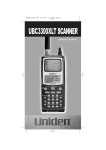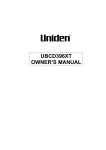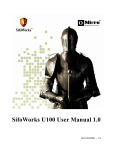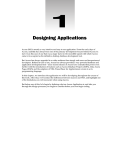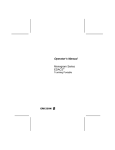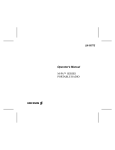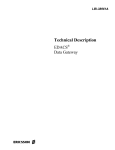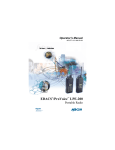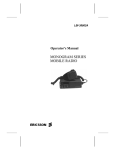Download Ericsson EDACS IPE SERIES User`s manual
Transcript
User’s Manual EDACS® IPE Series Radio ericssonz NOTICE! This manual covers Ericsson and General Electric products manufactured and sold by Ericsson Inc. NOTE! Repairs to this equipment should be made only by an authorized service technician or facility designated by the supplier. Any repairs, alterations or substitution of recommended parts made by the user to this equipment not approved by the manufacturer could void the user’s authority to operate the equipment in addition to the manufacturer’s warranty. NOTE The software contained in this device is copyrighted by Ericsson Inc. Unpublished rights are reserved under the copyright laws of the United States. This manual is published by Ericsson Inc., without any warranty. Improvements and changes to this manual necessitated by typographical errors, inaccuracies of current information, or improvements to programs and/or equipment, may be made by Ericsson Inc., at any time and without notice. Such changes will be incorporated into new editions of this manual. No part of this manual may be reproduced or transmitted in any form or by any means, electronic or mechanical, including photocopying and recording, for any purpose, without the express written permission of Ericsson Inc. Copyright© May 1996, Ericsson Inc. 2 TABLE OF CONTENTS INTRODUCTION . . . . . . . . . . . . . . . . . . BASIC OPERATION . . . . . . . . . . . . . . . . TURNING THE RADIO ON . . . . . . . . . . . . PLACING AN INDIVIDUAL CALL . . . . . . . . . PLACING A GROUP CALL . . . . . . . . . . . . PLACING AN EMERGENCY CALL . . . . . . . ANSWERING AN INDIVIDUAL CALL . . . . . . PLACING AN INTERCONNECT CALL . . . . . . Nobody Answers or You Hear a Busy or Fast Busy Tone . . . . . . . . . . . . . . . . Last Number Re-Dial . . . . . . . . . . . . . A Call is Unsuccessful or a Call in Progress is Interrupted . . . . . . . . . . . . . . . . ANSWERING AN INTERCONNECT CALL . . . Unanswered Call Counter . . . . . . . . . . SYSTEM SELECTION . . . . . . . . . . . . . . . GROUP SELECTION . . . . . . . . . . . . . . . . GROUP SCAN . . . . . . . . . . . . . . . . . . . VOLUME CONTROL KNOB . . . . . . . . . . . HANDSFREE Volume Control . . . . . . . . MUTE KEY . . . . . . . . . . . . . . . . . . . . AIR TIME METER . . . . . . . . . . . . . . . . . TURNING THE UNIT OFF . . . . . . . . . . . . DISPLAY, KEYPAD, AND AUDIBLE SIGNALS . . . DISPLAY . . . . . . . . . . . . . . . . . . . . . Alphanumeric Field . . . . . . . . . . . . . Numeric Field . . . . . . . . . . . . . . . . Status Indicators . . . . . . . . . . . . . . . BUTTON . . . . . . . . . . . . . . . . . . . . . KEYPAD . . . . . . . . . . . . . . . . . . . . . . MENU . . . . . . . . . . . . . . . . . . . . . . . . Illumination . . . . . . . . . . . . . . . . . . ALERT TONES . . . . . . . . . . . . . . . . . . . AUDIBLE SIGNALS . . . . . . . . . . . . . . . . Ringing Signal . . . . . . . . . . . . . . . . Error Signal . . . . . . . . . . . . . . . . . Malfunction Alarm Signal . . . . . . . . . . ELECTRONIC LOCK AND CALL RESTRICTIONS SETUP LOCK CODE . . . . . . . . . . . . . . . 5 7 7 8 9 9 10 10 12 12 12 12 13 13 14 14 15 15 15 15 16 16 16 16 17 17 18 18 19 22 22 24 24 25 25 25 26 3 TABLE OF CONTENTS (CONT’D) STORING NUMBERS . . . . . . . . . . . . . STORING A NUMBER (AND NAME) . . . . MEMORY PROTECTION . . . . . . . . . . MEMORY FULL . . . . . . . . . . . . . . . RECALLING NUMBERS . . . . . . . . . . . . Displaying Extended Digits . . . . . . . Alpha Recall . . . . . . . . . . . . . . . Recalling a Number by Entering the Memory Location . . . . . . . . . . . . Appending Digits to a Recalled Number Changing a Recalled Number . . . . . . SPEED CALLING . . . . . . . . . . . . . . ERASING A STORED NUMBER . . . . . . RECALLING A NUMBER DURING A CALL . DTMF SIGNALING . . . . . . . . . . . . . . . DTMF SIGNALING USING THE KEYPAD . . ACCESSING USER MENU FUNCTIONS . . . MENU FUNCTION DEFINITIONS . . . . . . BATTERIES AND RECHARGING . . . . . . . BATTERIES . . . . . . . . . . . . . . . . . Battery Level Indicator . . . . . . . . . Low Battery Alert . . . . . . . . . . . . Care and Maintenance . . . . . . . . . Rechargeable Battery Pack Disposal . . Inserting and Removing a Battery . . . RECHARGING . . . . . . . . . . . . . . . . Using a Desk-Top Charger . . . . . . . Restoring Battery Capacity . . . . . . . INTRINSICALLY SAFE USAGE . . . . . . . . BATTERY PACKS . . . . . . . . . . . . . . ACCESSORIES . . . . . . . . . . . . . . . APPENDIX 1 . . . . . . . . . . . . . . . . . . FAULT TRACING . . . . . . . . . . . . . . No Power to the Radio . . . . . . . . . SERV Indicator Does Not Come On . . Received Signal is Weak . . . . . . . . A Call Cannot be Placed . . . . . . . . "LOCKED" Is Displayed . . . . . . . . . WARRANTY . . . . . . . . . . . . . . . . . . 4 . . . . . . . . . . . . . . 27 27 29 30 31 31 31 . . . . . . . . . . . . . . . . . . . . . . . . . . . . . . . . . . . . . . . . . . . . . . . . . . . . . . . . . . . . . . 33 33 34 34 34 35 35 35 36 37 42 42 42 43 43 44 45 46 47 48 49 49 50 51 51 51 51 51 52 52 54 INTRODUCTION This manual describes how to use the IPE Series Portable Radios. The IPE (Infinity) is a synthesized, microprocessor-based, duplex portable FM radio providing reliable two-way communications in Enhanced Digital Access Communications System (EDACS) trunking environments. Duplex is provided in EDACS systems while operating in the Telephone Interconnect Mode. At other times, the radio provides simplex communications; i.e., when placing group calls in the EDACS environment. In an EDACS trunked environment the user selects a communications system. In this mode, channel selection is transparent to the user and is controlled via digital communication with the system controller. This provides advanced programmable features and fast access to communication channels. The exact operation of the radio depends on the radio mode, the operating mode, the radio’s programming, and the particular radio system. Most features described in this manual may be enabled or disabled through programming. Consult the system administrator for the required features to be programmed into the radio. 5 UPPER MICROPHONE MONITOR BUTTON PUSH-TOTALK (PTT) EMERGENCY BUTTON VOLUME SPEAKER LCD DISPLAY SYSTEM VERSION ONLY LOWER MICROPHONE 6 BASIC OPERATION TURNING THE RADIO ON E Turn the radio on by holding down the key until you hear a beep. E The display illumination comes on. All the status indicators and all the segments in the alphanumeric and numeric fields in the display will light momentarily. The radio’s LID number is displayed briefly. Own Logical ID System Indicator Battery Level Indicator LID Symbol A battery level indicator is shown in the upper right corner of the display. This can be a value from B0 to B5 in proportion to the battery’s voltage level. You can read more about this in the paragraph Batteries and Recharging. Once service is available from an EDACS system, the SERV (Service) indicator comes on and the CC SCAN goes off in the display. 7 Note the following points: • If the SERV indicator does not come on, you have lost contact with the EDACS system and cannot, therefore, place or receive any calls. Refer to Appendix 1 for further information. PLACING AN INDIVIDUAL CALL 1. # Press the key followed by the LID of the unit you wish to call. These digits are shown in the second line of the display. If you enter a wrong digit or a wrong LID: C Erase a wrong digit by pressing the key momentarily. You may delete all wrong digits individually like this, or eliminate all entered digits by holding the key for approximately 1 second. If key will also you are not in a call, pressing the delete all entered digits. C 8 E 2. After you have entered the LID, press the [PTT] key. The text *INDV* will appear on the first line of the display after the system acknowledges the call. 3. When the conversation is finished, press the key. E PLACING A GROUP CALL To place an EDACS Group Call on the desired Group (refer to GROUP SELECTION for further information) simply press the [PTT] key and speak into the microphone. PLACING AN EMERGENCY CALL Press and hold the Emergency button for approximately 2 seconds. The EMG icon will begin to flash and the word *EMERG* will appear in the display. NOTE This feature can be disabled in the radio’s personality. To clear an EMERGENCY (supervisory function only): Select the Group where the Emergency is active. Press and release the Emergency button and then press and release the key. The radio will send the Clear Emergency message. C 9 ANSWERING AN INDIVIDUAL CALL When you are being called, the radio will beep every 5 seconds to alert you of the incoming call and will continue until any key is pressed. The backlight flashes while the word ICALL and the calling unit’s LID flash in the display. Press the [PTT] key to return the call, the flashing will stop. The TX and BSY symbols will turn on while transmitting. When the conversation is finished, press the key. E Unanswered ICALLS will cause the WHC symbol to flash. The LID of the calling radio can be recalled by twice. pressing # PLACING AN INTERCONNECT CALL 1. Enter the desired number on the numeric keys. The digits are shown in the display. If you enter a wrong digit or a wrong number: C Erase a wrong digit by pressing the key momentarily. You may delete all wrong digits individually like this, or eliminate all entered digits by holding the key for approximately 1 second. If C 10 you are not in a call, pressing the delete all entered digits. 2. E key will also When you have entered the number, press S . The text DIALING shows in the display and the TX and BSY symbols come on. The number dialed will remain in the display until any key is pressed, or the call is ended, at which time the minutes and seconds of the call will be displayed. The left two digits show minutes, and the right two digits show the seconds (separated by two dashes). 3. When the conversation is finished, press E . 11 Nobody Answers or You Hear a Busy or Fast Busy Tone E . The telephone number will be rePress tained in the memory and you can easily repeat the call. Last Number Re-Dial M M > Press , then to scroll to the RECALL function. Then press , the word LAST DIAL will appear and the last dialed number will be displayed. Press to place the call. M S The last number called will remain in the memory even if the radio is turned off. A Call is Unsuccessful or a Call in Progress is Interrupted An error signal (a short beep) is heard. Refer to Appendix 1 for further information. ANSWERING AN INTERCONNECT CALL When you are being called, the radio rings according to the setting in the Menu Mode. The backlight flashes Green while the word CALL also flashes in the display. 12 S E S Press to answer. The TX and BSY symbols will light up and CALL will be removed. When the conversation is finished, press E . Unanswered Call Counter If one or more calls have not been answered, the number of unanswered calls will be displayed. For example, 02 CALLS. The unanswered call counter will reset as soon as you press any key. SYSTEM SELECTION To select the EDACS system for operation from the available systems stored by PC programming, the menu function is used. M > 1. Press . Then use the key to scroll to the SYSTEM menu (3rd menu selection). The current system will be displayed. 2. Press any digit key (0-9) to scroll through the list of pre-programmed systems. Press to store desired selection. The word STORED will appear in the display to indicate that a new system has been selected. M 13 3. Press E to exit from the menu function. GROUP SELECTION EDACS group selections are also made through the user menu. M > 1. Press . Then use the key to scroll to the GROUP menu (4th menu selection). The current Group will be displayed. 2. Press any digit key (0-9) to scroll through the Group Set for the currently selected System. Another press of the key will store the new selected group. M 3. 4. * key is used to add the While scrolling, the Group to the Group Scan List, the SCN symbol will indicate the Group has successfully been key is used to delete the Group added. The from the Group Scan List. Press the # E key to exit from the user menu. GROUP SCAN C To enable Group Scan press key. The flashing SCN symbol will indicate that the scan function is turned on. All groups previously entered into the Group Scan List will be monitored. 14 VOLUME CONTROL KNOB Keypad volume and earpiece volume is adjustable from the knob on top of the radio. HANDSFREE Volume Control < > During handsfree operation you can adjust the volume with these keys. MUTE KEY M During a phone conversation, the microphone can be deactivated by holding down the key. Release the key to resume the conversation. The display will show MUTE while muted. M M AIR TIME METER During a call, the elapsed air time, in minutes and seconds, is displayed. Minutes Seconds 15 The air time of the outgoing call includes the time taken to connect the call. NOTE The air time meter is only a guide; actual billing time from your service provider may differ. TURNING THE UNIT OFF E E E Press and hold down the key until you hear a beep. If a call is in progress, end the call by key, wait a few pressing and releasing the seconds, and then press and hold down the key until you hear a beep. DISPLAY, KEYPAD, AND AUDIBLE SIGNALS DISPLAY Alphanumeric Field • Displays names and memory locations, etc. • Displays messages, queries, and warnings. • Displays "air time" during a call. 16 E • Displays battery level indicator. Numeric Field Displays the telephone number entered on the keypad, or recalled from memory. Status Indicators EMG Emergency. Indicates that an emergency is declared on the current group. SERV Service. Indicates control channel. TX Transmit. Indicates unit is transmitting. SCN Scan. During Group selection it indicates Group has been added to the Group Scan List. Flashing indicates scan function is turned on. BSY Busy. Unit is active in some type of call. Shown during a call and also while an outgoing call is being connected. Flashes while the radio is queued. WHC Who Has Called. Flashes to indicate that you received an Individual Call. Battery. Flashes when battery reaches level B0. 17 BUTTON PUSH-TO-TALK (PTT button) Located on side. Enables radio’s transmitter. PTT must be held down to transmit during simplex operation. MONITOR Located on side. Same function as key on keypad except it will not turn power on/off and it will not end a phone call. KEYPAD 18 E E END ON/OFF E If a call is in progress, pressing terminates the call. Otherwise you can turn the radio ON or OFF by holding down the key until you hear a beep. This key is also used to exit from any sub-mode and return to the standby mode. May also be used to delete all entered digits while outside of a call. S SEND Places a call after a number has been entered, or recalled from the memory, and answers an incoming call. M MENU This key has two different functions: 1) MENU and 2) Mute Key. MENU M Press to select the Special Functions of the radio. Refer to paragraph, User Menu Functions. 19 Mute Key (Microphone Mute) M M Hold down to mute the microphone during a conversation. If the radio is used with hands free equipment, the separate microphone will be muted. HANDSFREE Volume Control > < To change the volume during handsfree operation simply press and hold or arrows until the desired level is reached. > < Also cycles through menu options after pressing . M C CLEAR Press the functions. C key for either of the following C 1. If is pressed momentarily, it erases the last digit or letter entered. Clear can be executed repeatedly to erase several characters. C 2. If is held down for at least one second, it erases all digits displayed, for example, a telephone number from the display. 20 3. Pressing function. C will turn on/off Group Scan C 4. Pressing while in MENU will exit to the group display. Numeric Keys 1 2 ... 9 0 Used to enter telephone numbers to be called, or stored in the memory. Used to enter memory locations when recalling telephone numbers. Used to scroll to an option within the menu function. When in Alpha mode, letters and digits can be entered. Press the appropriate numeric key once, twice, 3 or 4 times according to the position of the desired letter on the key. (Digit is fourth position). * Star Used when entering an automatic pause before a sequence of digits that is to be sent in a cluster as DTMF signals. Press . Refer to and then, within two seconds, the paragraph, DTMF Signaling. * M 21 Used in Alpha mode to enter a space or a star. # Pound Used when entering a manual pause before a sequence of digits that is to be sent in a cluster as DTMF signals. Press and . Refer to the then, within two seconds paragraph, DTMF Signaling. # M Used when placing an Individual Call. Refer to paragraph PLACING AN INDIVIDUAL CALL. Illumination The display and keys are illuminated. The light will be on if the phone is being dialed, or if a key has been pressed. After 10 seconds of inactivity the light will automatically turn off. See the paragraph on User Menu Functions for further information on this option. ALERT TONES The IPE Series radios generate a set of unique alert tones to indicate operating status. The following section identifies and describes the alert tones used in the Duplex radio for EDACS applications. 22 CALL ORIGINATE ALERT If programmed, a short tone is sounded whenever the key or PTT button is pressed and the radio has acquired a channel. This tone indicates the user may begin communications. S CALL QUEUED If no tone is heard after the transmitter is keyed and the BSY icon flashes, this indicates that the system key or has placed the request in a queue. If the PTT button is pressed while in queue, the radio autokeys (automatically keys) when a channel becomes available (see AUTOKEY). S S AUTOKEY key or PTT button is pressed to place When the a call on the system, but is released before the channel is assigned (e.g., a queued call), the radio automatically keys on the channel when it gets the assignment. The radio generates a long beep and holds the transmitter keyed for two seconds. Pressing the PTT button keeps the channel and sends the message before this two second time-out has expired. S SYSTEM BUSY key or PTT button a short tone is If after pressing heard and the words SYS BUSY appear on the display, this indicates that your calling party is either already on the system or the system queue is full. You must rekey later to access the system. 23 S CALL DENIED If after pressing key or PTT button a short tone is heard and the word DENIED appears on the display, this indicates that the system has denied your request. This happens when either the caller or callee unit LIDs are not valid on the system. OUT OF RANGE/SYSTEM INOPERATIVE If the radio is searching for a channel when PTT or is pressed, a single tone sounds immediately after the key or PTT button is pressed indicating the radio is out of range of the repeater. Otherwise the radio tries to place the call for a short period (3 seconds) after the initial attempt. If it cannot then reliably communicate with the system, the radio generates a low pitched tone and displays NO ACCESS when it gives up trying to place the call. The system is off the air or the radio needs servicing when the radio is within calling range, and these tones are heard. Observe the SERV icon and the CC SCAN display to determine when the system is in range and/or operational again. SS AUDIBLE SIGNALS Ringing Signal The ringing signal sounds when a call is received. It will be repeated until the call is answered or is terminated by the system. There is a special function to allow you to set the volume of the ringing signal. The ringing volume can be 24 set to one of several different signals. See the paragraph User Menu Functions. Error Signal A short beep tells you have done something incorrectly. For example, if you try to store a telephone number in a memory location that is already in use, or if you try to place a call when the SERV indicator is not present in the display. Malfunction Alarm Signal A long beep will be heard if: • The attached battery is becoming exhausted. The warning LOW BATT will also flash in the display. Refer to the paragraph Batteries and Recharging. ELECTRONIC LOCK AND CALL RESTRICTIONS In this function the radio may be locked completely, blocks out going calls but can still receive calls. The 4-digit personal Code may also be changed from this function. IMPORTANT The radio is factory programmed with a lock code of 0000. To improve security, enter a personalized four digit code by using the ALTER CODE option. 25 An option is set by entering the menu, toggling to the right alternative and pressing . The telephone then prompts for the personal code. If the right code is entered, the option is set. (To change the personal code,the code must be entered, then the new code must be entered and verified). M When the radio is completely locked, the option LOCK AUTO is set and the text LOCKED is shown in the display. If the right 4-digit code is entered, the text UNLOCKED will be displayed for 5 seconds and the lock is temporarily removed. When the phone is powered off, the lock becomes active again. The only way to permanently remove the lock is to enter this menu and select another option. If the option LOCK OFF is set, no restriction is active. If an incorrect personal code is entered, WRONG CODE appears in the display and the display returns to manual standby mode. SETUP LOCK CODE 1. 2. 26 M. Press > key to scroll to LOCK. Press 3. Press any digit key (1-9) to scroll to ALTER CODE. 4. Press M. 5. Enter OLD code. 6. Enter NEW code. 7. Enter NEW code (to verify new code). 8. Press 9. Press M to store new code. E to exit from menu function. STORING NUMBERS You can store often used telephone numbers in the radio’s memory, both when the radio is in standby mode and during a conversation. Numbers can be stored with, or without, an accompanying name. A number to be stored may contain up to 26 digits, and a name up to 8 letters, including spaces. Up to 25 numbers may be stored depending on the number of systems and groups already configured. STORING A NUMBER (AND NAME) 1. Enter the telephone number you wish to store. If you make a mistake, you can erase a wrong digit by pressing the key. C 27 2. M M M > Press . Then press to scroll to STORE --. Press and the word STORE is displayed, followed by the first free memory location, for example 22. > 3. To store the number in this memory location, go to step 5. 4. To store the number in a different memory location, enter the number of the memory location, for example 11. 1 1 28 M 5. Press again. The question NAME? appears. This indicates that you can now enter an accompanying name if you wish to do so. 6. Enter the first letter of the name. Pressing a different key or waiting for one second will move the cursor to the next position. You can enter up to eight letters. - To enter a letter, press the appropriate numeric key once, twice, or three times, depending on the position of the letter on the key. - To enter a number, press the appropriate numeric key four times. - If you make a mistake, correct it by pressing the key. C 7. When you have entered the entire name, press . The number and name are stored. M NOTE M If you do not wish to enter a name, press when the question NAME ? appears. The number will then be stored without a name. M If you do not press , the number (and name) will be stored automatically after about 20 seconds. MEMORY PROTECTION If you try to store a number in a memory location which already contains a number, a short beep is heard and the word USED flashes in the display for five seconds. 29 You can choose either to: a. Store the number in a different memory location. Enter the number of the memory location and press . M b. Store the number under the selected memory location, thus erasing the old number (and name). Just press . M MEMORY FULL If, when you attempt to store a new number, all memory locations are in use, STORE ? - - is displayed. If you do not wish to store the number, press the key or the key. C E If, on the other hand, you do wish to store the number, you can do the following: 30 Store the number in an already occupied memory location, thus erasing the old number (and name). Enter the required memory position and press . M RECALLING NUMBERS There are two ways of calling a stored number. You can either recall the number so that it appears in the , or if you are display and then call it by pressing certain of the memory location, enter the memory loca(speed calling). tion and press just S S Displaying Extended Digits If you recall a telephone number which has 26 digits, the number will be displayed in blocks of numbers starting with the first 6 digits, followed by the next ten (10) digits, and then the last ten (10) digits. Alpha Recall Only applies to telephone numbers stored with an accompanying name. 1. M > Press . Press to scroll to RECALL --. Press twice and the word LETTER - appears. M M 31 2. Enter the first letter of the name by pressing the relevant numeric key once, twice or three times, depending on the position of the desired letter. 2 3. The first name match will be displayed. 4. If the desired name is not displayed, scroll through the names by holding down the key until you find it. The names will be sorted alphabetically. If you scroll past the name you can go backward by repeatedly pressing the key. > < 5. 32 To place a call, press S . Recalling a Number by Entering the Memory Location M. Press > to scroll to RECALL-- 1. Press 2. Enter the memory location (one or two digits). The number (and name) appears in the display. 8 If you are uncertain of the memory location, enter a lower memory location and then scroll forward by holding down the key until you find the number. If you scroll too far, you can go backward by repeatedly pressing the key. > 3. To place the call, press S < . Appending Digits to a Recalled Number If you have stored a partial number you can recall it from the memory and then append the remaining digits. 33 Changing a Recalled Number A telephone number recalled from the memory can be altered by erasing the last digits using the key, and then entering new digits. C SPEED CALLING S A stored number can be called by just entering the . The memory location (one or two digits) and pressing number appears in the display. 9 S If you called a wrong number, you can press before the call has been connected. E ERASING A STORED NUMBER A stored number (and name) will be erased automatically if you store a new number in the same location. However, you can erase a number without replacing with a new number, by proceeding as follows: 34 C 1. Press key and hold for approximately 1 second to erase any entered digits. 2. Press 3. Enter the desired location, for example 22. Press . The warning message USED flashes for 5 seconds. M M. Press > to scroll to RECALL--. 4. M Press again. The message CLEARED is displayed for 5 seconds, and the number (and name) stored in location 22 are now erased. RECALLING A NUMBER DURING A CALL You may recall a memory location during a call. The number in that location may then be sent using DTMF (Dual Tone Multi-Frequency) tones. See the paragraph DTMF Signaling for further information. DTMF SIGNALING You can use your radio to send DTMF (Dual Tone Multi Frequency) signals to perform banking by phone, controlling answering machines , and other functions. DTMF SIGNALING USING THE KEYPAD If click sounds, or nothing, are heard when you press the keys, use the menu function to select KEY BURST or KEY CONT to turn the key tones on. Refer to the paragraph User Menu Functions. If you select the Burst option, a tone of fixed length will sound when you press a numeric key. With the Continuous option, a tone will sound as long as a numeric key is pressed. If you select the "Clicks" option, you will hear keyclicks in the speaker, but DTMF tones will be transmitted. 35 To send DTMF signals: 1. Call the desired number. 2. When the call has been connected, pressing keys 0 - 9, *, and # will cause the corresponding DTMF signals to be sent. ACCESSING USER MENU FUNCTIONS To access the user menu functions: 1. 2. M. Press > to scroll forward or < to scroll backward Press to select desired function. 3. Press any digit key (0-9) to select an option within a function. 4. Press 5. 36 M to store desired option. Press > or < to continue to scroll through menu function or press E or C to exit menu. MENU FUNCTION DEFINITIONS Menu Position 1 2 3 4 5 6 7 8 9 10 11 12 13 14 15 Function Store telephone number (name) Recall telephone number (name) Select system Group Selection Electronic Lock Battery Saver Ring Volume Ring Tone LCD contrast Key Burst, Tones, Clicks Backlight Selector Bat. Voltage Pers Program Resettable Accumulated Call Time Last Call Time (1) STORING NUMBERS (and names): Lets you store telephone numbers (names) in memory. First enter the number to be stored, then press and select STORE. M > Default: STORE -STORE --: Store number in memory by entering memory location and then pressing . NAME: Stores name associated with stored number. M 37 (2) RECALL NUMBERS (and names): Lets you recall telephone numbers (names) from memory. Default: RECALL -RECALL --: Recall number from memory by entering memory location and then pressing . LAST DIAL: Recall last number dialed by just pressing . LETTER-: Recall number from memory by entering names. M M (3) SYSTEM SELECTION: Lets you select the system operation. Default: Current System Use any digit key (0-9) to scroll through the list of programmed systems. Press to select new systems. M (4) GROUP SELECTION: Allows selection of different EDACS Groups. Default: Current Group Use any digit key (0-9) to scroll through the current Group Set. Press to store the selected group. M 38 (5) ELECTRONIC LOCK: Lets you lock the radio to restrict unauthorized use and enter personal lock code. Default: LOCK OFF LOCK OFF: No restrictions, the radio can send and receive calls. LOCK AUTO: The radio can receive calls only. The Keypad is "locked" automatically at power on. ALTER CODE: Allows you to change your personal lock code. (6) BATTERY SAVER (SLEEP CONTROL): Lets you select the amount of battery savings. WARNING If sleep mode is set to Normal or Extended, the radio may miss group calls or individual calls unless the calling radio remains keyed for at least 5 seconds after its access beep. To prevent missed calls select SLEEP OFF. Default: NORMAL NORMAL: EXTENDED: OFF: 39 (7) RING VOLUME: Lets you select the ring volume signal. Default: RING HIGH Note: One ring signal is sounded for each corresponding Ring Volume displayed. RINGSILENT: Ring signal is silent. the low battery warning only clicks once. RING LOW: Ring signal is continuous and low. RING MED: Ring signal is continuous and medium. RING HIGH: Ring signal is continuous and high. RING STEP: Ring signal is stepped and low. (8) RING TONE: Lets you select the ring tone frequency. Default: TONE HIGH Note: One ring signal is sounded for each corresponding Ring Tone displayed. TONE LOW: Frequency tone is low. TONE MED: Frequency tone is medium. TONE HIGH: Frequency tone is high. TONE MIXED: Frequency tone cycles through the high, medium, and low tones. (9) LCD CONTRAST: Not Available 40 (10) KEY BURST, TONES, OR CLICKS: Lets you select whether keypad numeric keys (0-9, #, *) produce DTMF tones or key clicks. Default: KEY CONT. KEY BURST: Burst mode avoids double-digiting error. The radio signal may drop out very briefly when you make a call in motion. This drop out can cause equipment to interpret two or more digits when you only press one. Select this mode if you experience a double digit error often. KEY CONT: Some answering machines require continuous mode. Select this mode if you are having difficulty controlling answering machines. KEY CLICK: Click mode sends the digits as a DTMF tone, but the user hears a click. (11) BACKLIGHT SELECTOR: Keypad or display illumination to be automatic or switched off. Default: LIGHT AUTO. LIGHT AUTO: The illumination comes on for ten seconds after any key is pressed. The illumination stays on continuously if the radio is mounted in a car kit and turned on. LIGHT OFF: The illumination is off at all times. (12) BATTERY VOLTAGE: Shows the input battery voltage to the radio (for example, 6-3 = 6.3 volts). (13) PERS PROG: PC personality programming mode. 41 (14) RESETTABLE ACCUMULATED CALL TIME: Displays accumulated call time, in hours and minutes, since last reset. ACCUM TIME: Displays the accumulated time. RESET?--RCL: Resets to zero by pressing key. (15) LAST CALL TIME: Displays "air time" of last call in minutes and seconds. BATTERIES AND RECHARGING BATTERIES The IPE Series is designed for use with high quality Ericsson batteries provided in the package. Use of other batteries should be avoided as it may be hazardous and may result in voiding your radio’s warranty. Battery Level Indicator A number from B0 to B5, based on the battery level is shown on the right of the display. A fully charged battery will show B5. A battery which is almost discharged will indicate B1 or B0. 42 Low Battery Alert Your radio should typically provide ninety (90) minutes of continuous talk-time before needing to be recharged. An alert tone sounds for a short time and the message LOW BATT flashes in the display. The symbol will also flash. If the radio is left on, the low battery alert will sound and, eventually, the radio will turn itself off. If the low battery alarm sounds while a call is in progress, you should end the call as quickly as possible. If the call continues, the radio will turn itself off after a short period. Care and Maintenance The batteries are of Nickel Cadmium type. They have a long maintenance-free service life if properly treated. • Discharge battery completely before recharging. • Never let a battery get into contact with metal objects that may short-circuit the battery poles, for example a bunch of keys in a pocket. • Do Not disassemble a battery. 43 • A battery may explode if disposed of in a fire. • Use only Ericsson specified batteries and chargers. Rechargeable Battery Pack Disposal The product that you have purchased contains a rechargeable, recyclable battery. At the end of its useful life, under various state and local laws, it may be illegal to dispose of this battery into the municipal waste stream. Check with your local solid waste officials for details in your area for recycling options or proper disposal. Call Toll Free 1-800-8-BATTERY for information and/or procedures for returning rechargeable batteries in your state. 44 Inserting and Removing a Battery Standard Battery 45 RECHARGING Your charger is intended for indoor use only. Keep charger and AC adaptor dry. Do not use in or near water. Avoid recharging a battery before the low battery alert is displayed. Never recharge a battery when the ambient temperature is below 5°C or 40°F, or above 40°C or 105°F. The LED on the charger will indicate that charging is in progress. Remove the battery when the LED turns green. Do not leave the battery in the charger for more than 48 hours. Over-charging may reduce battery life. 46 Using a Desk-Top Charger 1. Connect the AC Adapter to the desk-top charger. 2. Plug the AC adapter into a wall outlet. 3. Remove the battery from the radio and lay it on the desk-top charger, radio side down. For longest battery life,remove the battery after charging. 47 Restoring Battery Capacity If you often recharge a battery before the low battery alarm has been issued, the battery’s ability to accept charge may be impaired. This will result in less and less time between recharges. To restore the battery, perform the following: 1. Use the radio as you normally would, until the low battery alarm has been issued. 2. Allow the radio to remain on until it turns itself off. 3. Charge the battery using the desk-top charger. After discharging and recharging the battery this way, it can be used for a longer period before the next recharge is required. To get the longest period between charges, repeat this procedure 3 or 4 times. Also if a battery has not been used for several months, it may require 3 or 4 charge-discharge cycles to return to full capacity. 48 INTRINSICALLY SAFE USAGE Selected portable radios with appropriate factory installed F4 Options are certified as Intrinsically Safe by the Factory Mutual Research Corporation. Intrinsically Safe approval includes Class l, II, Ill, Division 1 hazardous locations in the presence of Groups C, D, E, F and G atmospheres. Non-Incendive approval includes ClassI, Division 2 hazardous locations in the presence of Groups A, B, C and D atmospheres. Hazardous locations are defined in the National Electrical Code. Useful standards NFPA 437A and NFPA 437M for the classifications of hazardous areas can be ordered from the National Fire Protection Association, Batterymarch Park, Quincy, MA 02269. BATTERY PACKS Only battery packs identified with a green latch shall be used with a portable radio that is rated and labeled as Factory Mutual Intrinsically Safe. Use of non-specified battery packs voids Factory Mutual approval. The following battery pack options are approved for use in intrinsically safe radios: TBD 49 ACCESSORIES The accessories that follow are approved for use with intrinsically safe radios. Use of accessories other than those listed voids Factory Mutual approval. TBD 50 APPENDIX 1 FAULT TRACING No Power to the Radio E • If the radio does not come on when you hold down key, recharge or replace the battery. Refer the to paragraph Batteries and Recharging. SERV Indicator Does Not Come On You have lost contact with the EDACS system and you cannot place any calls. The reason for this is either: • The received signal is too weak. See the next section, Received Signal is Weak • You are in an area which is not covered by the EDACS system selected. Received Signal is Weak If the radio displays CC SCAN often, move the radio to obtain a stronger signal. • Large obstacles such as buildings, hills and mountains can drastically affect the signal strength and you may have to move to obtain a sufficiently strong signal. • Indoors, it is usually best to use the radio near a window. 51 A Call Cannot be Placed The reason for this is either: • The phone number displayed may be incorrect. • The radio may not be in service or the signal is weak. See the prior sections. • The EDACS system you are using requires or does not allow the phone number to be preceded by a "1" or the area code. Try various combinations or contact the operator for more information. • You are roaming and the EDACS system you are using doesn’t have a roaming agreement with your home system. "LOCKED" Is Displayed The radio is locked to prevent unauthorized use. To unlock: 52 1. If anything is shown on the numeric field of the display, erase it with the key. 2. Enter the 4-digit code lock code. UNLOCKED will be displayed briefly. C PERSONAL MEMORY DIRECTORY Mem. Loc. Name LID or Tel. No. 1 2 3 4 5 6 7 8 9 10 11 12 13 14 15 16 17 18 19 20 21 22 23 24 25 53 WARRANTY A. Ericsson Inc. (hereinafter "Seller") warrants to the original purchaser for use (hereinafter "Buyer") that Equipment manufactured by Seller shall be free from defects in material, workmanship and title, and shall conform to its published specifications. With respect to any Equipment not manufactured by Seller (except for integral parts of Seller’s Equipment to which the warranties set forth above shall apply). Seller gives no warranty, and only the warranty, if any, given by the manufacturer shall apply. Batteries are excluded from this warranty. B. Seller’s obligations set forth in Paragraph C below shall apply only to failures to meet the above warranties (except as to title) occurring within the following periods of time from date of sale to the Buyer and are conditioned on Buyer’s giving written notice to Seller within thirty (30) days of such occurrence: 1. for fuses, incandescent lamps, vacuum tubes and non-rechargeable batteries, operable on arrival only. 2. for parts and accessories (except as noted in B.1) sold by Seller’s Service Parts Operation, ninety (90) days. 3. for all other Equipment of Seller’s manufacture, one (1) year. C. If any Equipment fails to meet the foregoing warranties, Seller shall correct the failure at its option (i) by repairing any defective or damaged part or parts thereof, or (ii) by making available at Seller’s factory any necessary repaired or replacement parts. Any repaired or replacement part furnished thereunder shall be warranted for the remainder of the warranty period of the Equipment in which it is installed. Where such failure cannot be corrected by Seller’s reasonable efforts, the parties will negotiate an equitable adjustment in price. Labor to perform warranty service will be provided at no change only for the Equipment covered under Paragraph B.3, and only during the first three (3) months following the date of sale to the Buyer. Thereafter, labor will be charged at prevailing rates. To be eligible for no-charge labor, service must be performed by an Authorized Service Center or other Services approved for these purposes either at its place of business during normal business hours, for mobile or personal equipment, or at the Buyer’s location, for fixed location equipment. Service on fixed location equipment more than thirty (30) miles from the Service Center or other approved Service’s place of business will include a charge for transportation. Equipment located off-shore is not eligible for no-charge labor. D. Seller’s obligations under Paragraph C shall not apply to any Equipment, or part thereof, which (i) has been modified or otherwise altered other than pursuant to Seller’s written instructions or written approval or, (ii) is normally consumed in operation or, (iii) has a normal life inherently shorter than the warranty periods specified in Paragraph B, or (iv) is not properly stored, installed, used, maintained or repaired, or, (v) has been subjected to any other kind of misuse or detrimental exposure, or has been involved in an accident. E. The preceding paragraphs set forth the exclusive remedies for claims (except as to title) based upon defects in or nonconformity of the Equipment, whether the claim is in contract, warranty, tort (including negligence), strict liability or otherwise, and however instituted. Upon the expiration of the warranty period, all such liability shall terminate. The foregoing warranties are exclusive and in lieu of all other warranties, whether oral, written, expressed, implied or statutory. NO IMPLIED OR STATUTORY WARRANTIES OF MERCHANTABILITY OR FITNESS FOR PARTICULAR PURPOSE SHALL APPLY. IN NO EVENT SHALL THE SELLER BE LIABLE FOR ANY INCIDENTAL, CONSEQUENTIAL, SPECIAL, INDIRECT OR EXEMPLARY DAMAGES. This warranty applies only within the United States. 1-800-528-7711 (outside U.S.A., 804-528-7711) 54 NOTES 55 Emergency Numbers Police State Police Fire Poison Control Ambulance Life Saving & Rescue Squad Ericsson Inc. Private Radio Systems Mountain View Road Lynchburg,Virginia 24502 AE/LZT 123 1907 R1C 1-800-528-7711 (Outside USA, 804-528-7711) Printed in U.S.A.
























































